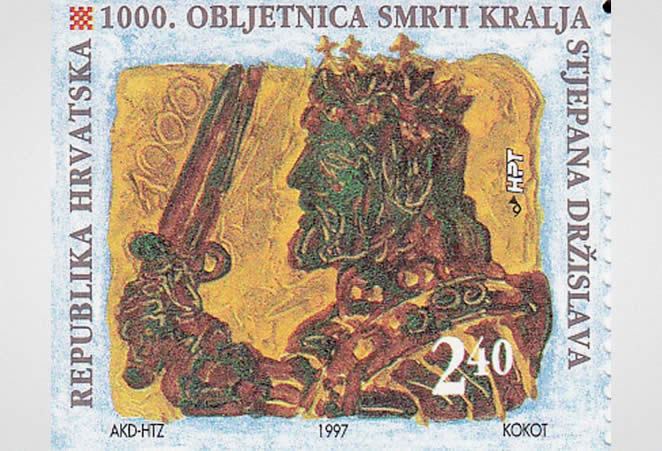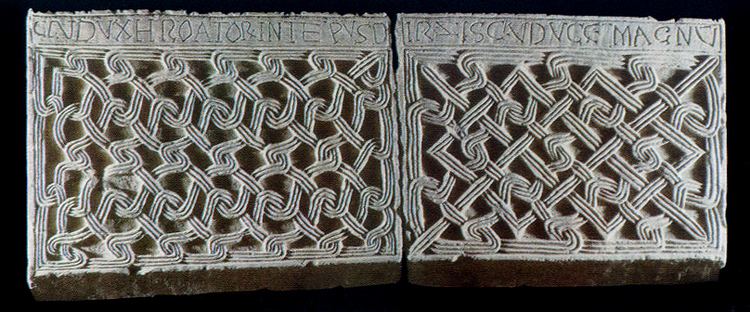Reign 969–997 Name Stephen of House Trpimirovic dynasty | Predecessor Mihajlo Kresimir II Died 997 AD Coronation 988 Role King | |
 | ||
Issue SvetoslavKresimir IIIGojslav Children Kresimir III of Croatia, Svetoslav of Croatia, Gojslav of Croatia Parents Michael Kresimir II of Croatia, Helen of Zadar Great grandchildren Peter Kresimir IV of Croatia | ||
Grandchildren Stephen I of Croatia Grandparents Kresimir I of Croatia | ||
Stephen Držislav (Croatian: Stjepan Držislav, Latin: Dirzislaus) (died 997) was King of Croatia from 969 AD until his death in 997. He was a member of the Trpimirović dynasty. He ruled from Biograd with Godemir as his Ban.
Contents
Early period

Stjepan Držislav was a son of king Mihajlo Krešimir II and his wife, queen Jelena of Zadar. Jelena acted as a regent for the young king from 969 until her death on 8 October 976. In a war of Byzantine emperor Basil II against Tsar Samuil of Bulgaria, Stjepan Držislav allied with the Byzantines. After the Byzantine Emperor Basil II managed to defend every single coastal Adriatic City during Samuil's rampage towards Zadar in 986, the cities were returned to Croatian control. Samuil, however, invaded central Croatia and conquered the territories of Bosnia between the rivers of Drina and Bosna. Samuil pursued some of his cousins during the war and they often sought help in Croatia. King Držislav had taken fourteen of them, gave them hospitality and a residence near Klis. According to the Archbishop of Split Martin, in 994 they collected money for the construction of the Orthodox St. Michael church in Solin.
In an effort to compensate and award Držislav for his alliance, the Eastern Roman Emperor named Stjepan Držislav Patriarch and an Exarch of Dalmatia, which gave him formal authority over the Theme of Dalmatia. Stjepan Držislav received royal insigia as an act of recognition from the Byzantine Emperor. He was crowned by the Archbishop of Split in Biograd in 988.
Držislav built on his parents' feats and secured sovereignty over the Theme of Dalmatia, lost to Byzantium under Trpimir II. The Theme of Dalmatia at that time included the towns (but not the hinterland) of Krk, Osor, Rab, Zadar, Trogir and Split. He also delegated much of his authority to his powerful governors (bans). He also invested considerable effort integrating the Latin minority with the Croatian majority.
Rule
The 13th-century work Historia Salonitana by Thomas the Archdeacon notes that Zachlumia (or Chulmie) was a part of the Kingdom of Croatia, before and after Stjepan Držislav.
In 996, Venetian Doge Pietro II Orseolo stopped paying tax for safe to the Croatian King after a century of peace, renewing old hostilities. Stjepan Držislav, together with the Neretvians, restored naval conflicts with the Venetian ships, but with little success. He sent delegates demanding the tribute to be paid, but the Doge was again reluctant and continued the war. Držislav died shortly after, leaving the country separated among his sons, which was used in advance for Venice. Before the end of his reign, Stjepan Držislav gave Svetoslav, his oldest son, the title of Duke and Svetoslav became his co-ruler. Držislav was preparing Svetoslav to be his successor. It is probable that Svetoslav ruled concurrently with his father during the 990s. Stone panels from the altar of a 10th-century church in Knin, reveal the following inscription in Latin: CLV DUX HROATOR IN TE PUS D IRZISCLV DUCE MAGNU. In English, this means: Svetoslav, Duke of the Croats at the time of Drzislav the Great Duke (Latin: dux magnis). The stone panels are kept at the Museum of Croatian Archaeological Monuments in Split.
Držislav's rule was one of the longest of Kings in Croatia, spanning nearly three decades. He had three sons: Svetoslav, Krešimir, and Gojslav, and all three of them were to hold the title of King of Croatia over the following decades. Stjepan Držislav died in 997, leaving his descendants to struggle for control over the Croatian Kingdom.
